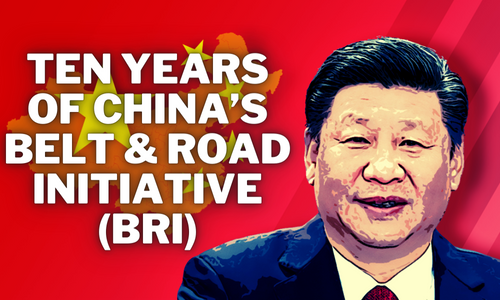Abstract
This paper looks at the transformative journey of China’s Belt and Road Initiative (BRI) since its inception in 2013. With a budget exceeding $1 trillion, the BRI has redefined global geopolitics, connecting over 70 countries across Asia, Europe, Africa, and Oceania. In addition to economic growth, BRI influences global supply chains, asserts technological dominance, and targets Eurasian trading markets. For a decade, it has contributed to global growth, economic growth, green energy, and infrastructure networks. The paper examines strategic challenges in the Indo-Pacific, highlights China’s military rise, and highlights economic concerns such as the Hambantota port in Sri Lanka advocating solutions for development sustainable means, and takes Japan’s infrastructure policy and explores global options. Providing a comprehensive analysis, the paper offers important insights for policymakers, scholars, and stakeholders in the evolving international network. India’s strategy includes leveraging China’s investments and ensuring national security through global cooperation and consensus building among stakeholders for the success of the BRI.
Introduction
China’s BRI has significantly reshaped the global geopolitical landscape since its inception in 2013. It includes a wide array of projects, ranging from transportation and energy infrastructure to the development of ports, railways, oil and gas pipelines, and power grids, as well as plans for new economic corridors. The overarching goal of this initiative is to revitalize the historical Silk Road, forging economic ties and fostering development among participating nations across Eurasia and Africa. Two speeches by Chinese President Xi Jinping in 2013 set the stage for the BRI project, emphasizing the need for closer economic ties, cooperation, and the expansion of development space in the Eurasian region. The scale of the BRI’s influence is not to be underestimated, as it now involves 147 countries, encompassing two-thirds of the world’s population and 40 percent of global GDP.
While celebrated for promoting peace and cooperation, the BRI has faced criticism, notably for alleged “debt-trap diplomacy” in African projects. Some view the initiative as an assertion of China’s growing global power, with concerns raised about its true intentions. The United States, skeptical of Beijing’s actions, expressed apprehensions about regional development and military expansion implications. India remains cautious, refraining from endorsing the One Belt, One Road (OBOR) initiative as a “national Chinese initiative.”
China’s Ambitious Path
The year 2012 and its past decade stand out as a crucial turning point in the beginning of the BRI. During this period, China found itself facing multifaceted challenges, including territorial and military conflicts in the South China Sea and the East China Sea, coupled with economic competition with the United States, summarized by the Trans-Pacific Partnership (TPP) negotiations. These external pressures were compounded by internal issues, such as industrial overcapacity and environmental pollution, which threatened the stability of the domestic economy.
The BRI’s global reach is staggering. By mid-2018, the Association of Southeast Asian Nations (ASEAN) member countries alone had already witnessed BRI projects valued at over $739.65 billion, signaling its profound influence in the region. Furthermore, the BRI’s expansion into Africa led to a significant tripling of loans from China to African nations between 2012 and 2019, underlining its growing impact on the African continent. Beyond that, the initiative has even extended its influence into South America, with China signing memoranda of understanding (MOUs) with seven countries in the region.
The BRI emerged as a strategic response to these challenges, reflecting a part of China’s broader strategic vision, often referred to as “China Goes West.” This vision aimed to de-escalate confrontations in maritime Asia by intensifying connectivity across Eurasian land, thereby providing an alternative route to economic expansion and influence. Chinese President Xi Jinping has signaled that the time has come for China to exert its strength and reclaim its historical place on the global stage.
Source: Green Finance and Development Center, Green Belt and Road Initiative, Belt and Road Portal.
The graph presented in this study provides a visual representation of the expanding partnerships within the BRI over the years. It vividly illustrates the geographical progression of BRI participation, highlighting how the initiative began with the involvement of a limited number of countries and gradually expanded its reach. The graph portrays the early phase of BRI partnerships, primarily concentrated in Asia and a few European countries. Over time, the initiative expanded beyond Asia and Europe, making inroads into the African continent and South America.
The bar plot presented below portrays the participation of countries within the BRI segmented by income categories. The plot highlights that the early adoption of the BRI was predominantly by upper-middle-income countries, with their participation surging in 2015. Conversely, the graph demonstrates a different trend for lower-middle-income, low-income, and high-income countries, with their participation surging in 2018. This indicates that, in contrast to upper-middle-income nations, these countries had a slightly delayed response to the BRI, with the peak of their engagement occurring later. This shift in timing reflects varying economic circumstances, political considerations, and infrastructure development needs across income categories.
Click Here To Download The Paper


📌Analysis of Bills and Acts
📌 Summary of Reports from Government Agencies
📌 Analysis of Election Manifestos

